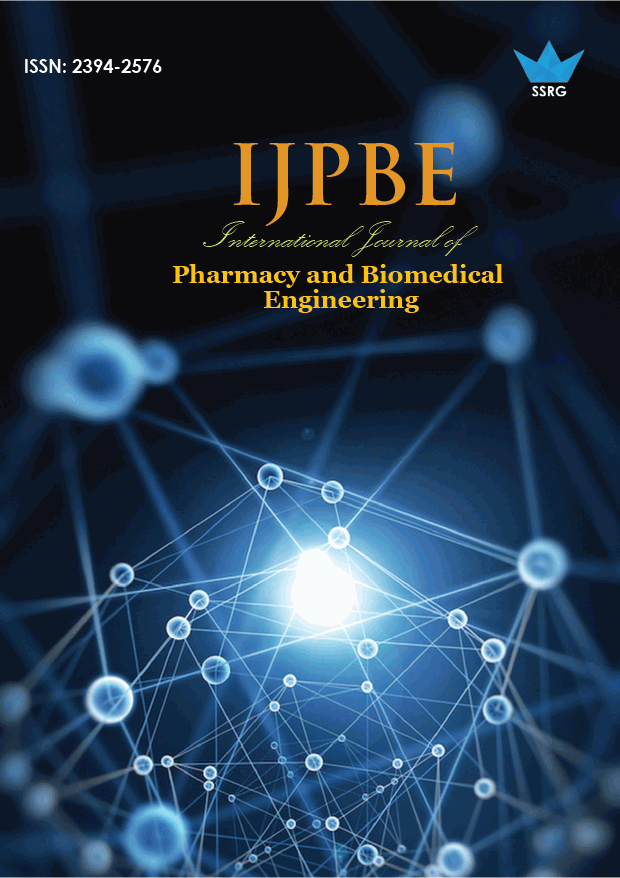Design and Implementation of Wireless Rehabilitation Aid for Tongue Disorders

| International Journal of Pharmacy and Biomedical Engineering |
| © 2017 by SSRG - IJPBE Journal |
| Volume 4 Issue 1 |
| Year of Publication : 2017 |
| Authors : Farhana Siddique, M. Saranya, M. Saranya Christabell and S. Prema |
How to Cite?
Farhana Siddique, M. Saranya, M. Saranya Christabell and S. Prema, "Design and Implementation of Wireless Rehabilitation Aid for Tongue Disorders," SSRG International Journal of Pharmacy and Biomedical Engineering, vol. 4, no. 1, pp. 4-7, 2017. Crossref, https://doi.org/10.14445/23942576/IJPBE-V4I1P102
Abstract:
The tongue is a muscular hydrostat, which is a part of the oral cavity. The interaction of language with the palate is essential for the articulation of speech and swallowing of food. Patients with neurological disorders have impaired speech and swallowing problems. A device is envisioned to provide a non-invasive rehabilitation aid for speech and swallowing disorders in this work. The proposed device serves as both a diagnostic and therapeutic tool. The proposed device parameters are tongue pressure measurement and tongue color detection along with neuromodulation stimulator (tongue stimulator – therapeutic aid). The output, a waveform (tongue pressure), and an image (tongue color) are transmitted wirelessly outside the oral cavity to the computer. This device is used to investigate and quantify the degree of tongue disorder. Periodic rehabilitation therapies and the proposed device increase the chances of recovery of functional tongue disorders by 50% within a short interval of time.
Keywords:
Tongue pressure measurement, tongue color detection, tongue stimulator.
References:
[1] E. Sardini, M. Serpelloni, and S. Pandini, "Analysis of tongue pressure sensors for biomedical applications," Conference paper June 2014.
[2] Stöhr, "Wireless sensor system for monitoring spatially resolved tongue pressure," Test Conference 2011.
[3] Kiran S Patil, Pallavi S Deshpande, "Tongue Diagnosis: A Non-Invasive Approach to Detect Diabetes Mellitus & Diabetic Retinopathy Using Color, Texture & Geometry Features," International Journal of Innovative Research in Science, Engineering and Technology, Vol. 4, Issue 7, July 2015.
[4] Kazuhiro Hori, Hiroshige Taniguchi1, Hirokazu Hayashi, Jin Magara, Yoshitomo Minagi, Qiang Li, Takahiro Ono & Makoto Inoue, "Role of tongue pressure production in oropharyngeal swallow biomechanics," Physiol Rep, 1 (6), 2013, e00167, doi: 10.1002/phy2.167.
[5] E. Sardini, M. Serpelloni, R.Fiorentini, "Wireless Intraoral sensor for the physiological monitoring of tongue pressure," Transducer 2013, Barcelona, Spain, 16-20 June 2013.
[6] O. Chenu, N. Vuillerme, J. Demongeot, and Y. Payan, "A Wireless Lingual Feedback Device to Reduce Overpressures in Seated Posture: A Feasibility Study," PLOS one 4(10), 2009, pp. 1-8.
[7] C.M. Steele, G.L. Bailey, S.M. Molfenter, E.M. Yeates, and K. G. Martin, "Pressure profile similarities between tongue resistance training tasks and liquid swallows," J. of Rehabilitation Research & Development 47(7), 2010, pp. 651–660.
[8] Müller, R.; Schuster, G.; Hohlfeld, O. et al.: Telemetrisches Messsystem zur Bestimmung des Druckes der Zunge gegen den Gaumen. Biomedizinische Technik. Vol. 48, 2003, S. 226-229.
[9] Stöhr, I.; Manderscheid, M.; Werthschützky, R.: Neuartiges polymerbasiertes Packaging von SiliziumDruckmesselementen zum Einsatz in der Kieferorthopädie. In: 9. Dresdner SensorSymposium, Dresden 2009
[10] T. Spencer, J. A. Olson, K. C. McHardy, P. F. Sharp, and J. V. Forrester, "An image-processing strategy for the segmentation of microaneurysms in fluorescein angiograms of the ocular fundus," Comput. Biomed. Res., vol. 29, pp. 284–302, 1996.
[11] M. Niemeijer, B. van Ginneken, J. Staal, M. S. A. SuttorpSchulten, and M. D. Abramoff, "Automatic detection of red lesions in digital colour fundus photographs," IEEE Trans. Med. Imag., vol. 24, no. 5, pp. 584–592, May 2005.

 10.14445/23942576/IJPBE-V4I1P102
10.14445/23942576/IJPBE-V4I1P102